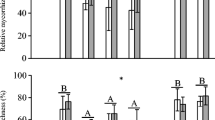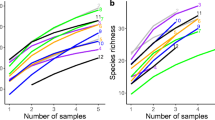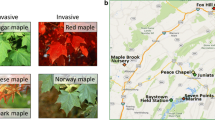Abstract
It is generally assumed that recruitment and expansion of alien species along elevation gradients are constrained by climate. But, if plants are not fully constrained by climate, their expansion could be facilitated or hindered by other factors such as biotic interactions. Here, we assessed the composition of arbuscular mycorrhizal fungi (AMF) in soils along an elevation gradient (i.e. 900 m, 1600 m, 2200 m and 2700 m a.s.l.) through a fungal DNA meta-barcoding approach. In addition, we studied in the greenhouse the effects of AMF on growth and phosphorous (P) nutrition of seedlings of the alien trees Gleditsia triacanthos, Ligustrum lucidum and Pyracantha angustifolia cultivated in soils from those elevations, spanning the elevation at which they already form monospecific stands (below 1450 m a.s.l.) and higher elevations, above their current range of distribution in montane ecosystems of Central Argentina. For comparison, we also included in the experiment the dominant native tree Lithraea molleoides that historically occurs below 1300 m a.s.l. Arbuscular mycorrhizal fungal community composition showed strong community turnover with increasing elevation. The effects of these AMF communities on plant growth and nutrition differed among native and alien trees. While P nutrition in alien species’ seedlings was generally enhanced by AMF along the whole gradient, the native species benefited only from AMF that occur in soils from the elevation corresponding to its current altitudinal range of distribution. These results suggest that AMF might foster upper range expansion of these invasive trees over non-invaded higher elevations.



Similar content being viewed by others
References
Alexander JM, Kueffer C, Daehler CC, Edwards PJ, Pauchard A, Seipel T, MIREN Consortium (2011) Assembly of nonnative floras along elevational gradients explained by directional ecological filtering. Proc Natl Acad Sci 108:656–661
Anacker BL, Klironomos JN, Maherali H, Reinhart KO, Strauss SY (2014) Phylogenetic conservatism in plant -soil feedback and its implications for plant abundance. Ecol Lett 17:1613–1621
Anderson MJ (2001) A new method for non-parametric multivariate analysis of variance. Aust Ecol 26:32–46
Aristizábal C, Rivera EL, Janos DP (2004) Arbuscular mycorrhizal fungi colonize decomposing leaves of Myrica parvifolia, M. pubescens and Paepalanthus sp. Mycorrhiza 14:221–228
Bellemain E, Davey ML, Kauserud H, Epp LS, Boessenkool S, Coissac E, Geml J, Willerslev E, Gussarova G, Taberlet P, Brochman C (2013) High paleodiversity of fungi revealed using high-throughput metabarcoding of ancient DNA from arctic permafrost. Environ Microbiol 15:1176–1189
Berruti A, Desiro A, Visentin S, Zecca O, Bonfante P (2017) ITS fungal barcoding primers versus 18S AMF-specific primers reveal similar AMF-based diversity patterns in roots and soils of three mountain vineyards. Environ Microbiol Rep 9:658–667
Bjorbækmo MFM, Carlsen T, Brysting A, Vrålstad T, Høiland K, Ugland KI, Geml J, Schumacher T, Kauserud H (2010) High diversity of root associated fungi in both alpine and arctic Dryas octopetala. BMC Plant Biol 10:244
Brown C, Vellend M (2014) Non-climatic constraints on upper elevational plant range expansion under climate change. Proc R Soc B 281:20141779
Bunn RA, Ramsey PW, Lekberg Y (2015) Do native and invasive plants differ in their interactions with arbuscular mycorrhizal fungi? A meta-analysis. J Ecol 103:1547–1556
Cabrera A (1976) Regiones fitogeográficas argentinas. In: Enciclopedia Argentina de Agricultura y Jardinería, 2nd edn. ACME, Buenos Aires
Callaway RM, Bedmar EJ, Reinhart KO, Silvan CG, Klironomos J (2011) Effects of soil biota from different ranges on Robinia invasion: acquiring mutualists and escaping pathogens. Ecology 92:1027–1035
Davison J, Moora M, Öpik M, Adholeya A, Ainsaar L, Bâ A, Burla S, Diedhiou AG, Hiiesalu I, Jairus T, Johnson NC, Kane A, Kooren K, Kochar M, Ndiaye C, Pärtel M, Reier Ü, Sacks Ü, Singh R, Vasar M, Zobel M (2015) Global assessment of arbuscular mycorrhizal fungus diversity reveals very low endemism. Science 349:970–973
Di Rienzo JA, Casanoves F, Balzarini MG, Gonzalez L, Tablada M, Robledo CW (2013). Infostat. Grupo InfoStat, FCA, Universidad Nacional de Córdoba, Argentina
Dickie IA, Bufford JL, Cobb RC, Desprez-Loustau ML, Grelet G, Hulme PE, Klironomos J, Makiola A, Nuñez M, Pringle A, Thrall PH, Tourtellot SG, Waller L, Williams NM (2017) The emerging science of linked plant-fungal invasions. New Phytol 215:1314–1332
Edgar RC (2010) Search and clustering orders of magnitude faster than BLAST. Bioinformatics 26:2460–2461
Furey C, Tecco P, Perez-Harguindeguy N, Giorgis MA, Grossi M (2014) The importance of native and exotic plant identity and dominance on decomposition patterns in mountain woodlands of Central Argentina. Acta Oecol 54:13–20
Geml J (2017) Altitudinal gradients in mycorrhizal symbioses—the current state of knowledge on how richness and community structure change with elevation. In: Tedersoo L (ed) Ecological studies: biogeography of mycorrhizal symbioses. Springer, Berlin, pp 107–123
Geml J, Laursen GA, Herriott I, McFarland JM, Booth MG, Lennon N, Nusbaum C, Taylor DL (2010) Phylogenetic and ecological analyses of soil and sporocarp DNA sequences reveal high diversity and strong habitat partitioning in the boreal ectomycorrhizal genus Russula Pers. (Russulales; Basidiomycota). New Phytol 187:494–507
Giorgis MA, Tecco PA, Cingolani AM, Renison D, Marcora P, Paiaro V (2011a) Factors associated with woody alien species distribution in a newly invaded mountain system of Central Argentina. Biol Invasions 13:1423–1434
Giorgis MA, Cingolani AM, Chiarini F, Chiapella J, Barboza G, Ariza Espinar L, Morero R, Gurvich DE, Tecco PA, Subils R, Cabido M (2011b) Composición florística del Bosque Chaqueño Serrano de la provincia de Córdoba, Argentina. Kurtziana 36:9–43
Giorgis MA, Cingolani AM, Tecco PA, Cabido M, Poca M, von Wehrden H (2016) Testing alien plant distribution and habitat invasibility in mountain ecosystems: growth form matters. Biol Invasions 18:2017–2028
Giorgis MA, Cingolani AM, Gurvich DE, Tecco PA, Chiapella J, Chiarini F, Cabido M (2017) Changes in floristic composition and physiognomy are decoupled along elevation gradients in Central Argentina. Appl Veg Sci 20:558–571
Grace C, Stribley DP (1991) A safer procedure for routine staining of vesicular-arbuscular mycorrhizal fungi. Mycol Res 95:1160–1162
Hazard C, Gosling P, van der Gast CJ, Mitchell DT, Doohan FN, Bending G (2013) The role of local environment and geographical distance in determining community composition of arbuscular mycorrhizal fungi at the landscape scale. ISME J 7:498–508
Helgason T, Merryweather JW, Denison J, Wilson P, Young JPW, Fitter AH (2002) Selectivity and functional diversity in arbuscular mycorrhizas of co-occurring fungi and plants from a temperate deciduous woodland. J Ecol 90:371–384
Hoeksema JD, Chaudhary VB, Gehring CA, Johnson NC, Karst J, Koide RT, Pringle A, Zabinski C, Bever JD, Moore JC, Wilson GWT, Klironomos JN, Umbanhowar J (2010) A meta-analysis of context-dependency in plant response to inoculation with mycorrhizal fungi. Ecol Lett 13:394–407
Hoeksema JD, Bever JD, Chakraborty S, Chaudhary VB, Gardes M, Gehring CA, Hart MM, Housworth EA, Kaonongbua W, Klironomos JN, Lajeunesse MJ, Meadow J, Milligan BG, Piculell BJ, Pringle A, Rúa MA, Umbanhowar J, Viechtbauer W, Wang YW, Wilson GWT, Zee PC (2018) Evolutionary history of plant hosts and fungal symbionts predicts the strength of mycorrhizal mutualism. Commun Biol 1:116. https://doi.org/10.1038/s42003-018-0120-9
Ihrmark K, Bödeker ITM, Cruz-Martinez K, Friberg H, Kubartova A, Schenck J, Strid Y, Stenlid J, Brandström-Durling M, Clemmensen KE, Lindahl BD (2012) New primers to amplify the fungal ITS2 region—evaluation by 454-sequencing of artificial and natural communities. FEMS Microbiol Ecol 82:666–677
Jansa J, Erb A, Oberholzer HR, Šmilauer P, Egli S (2014) Soil and geography are more important determinants of indigenous arbuscular mycorrhizal communities than management practices in Swiss agricultural soils. Mol Ecol 23:2118–2135
Jeschke JM, Aparicio LG, Haider S, Heger T, Lortie CJ, Pyšek P, Strayer DL (2012) Support for major hypotheses in invasion biology is uneven and declining. NeoBiota 14:1-20
Kivlin SN, Hawkes CV, Treseder KK (2011) Global diversity and distribution of arbuscular mycorrhizal fungi. Soil Biol Biochem 43:2294–2303
Kivlin SN, Lynn JS, Kazenel MR, Beals KK, Rudgers JA (2017) Biogeography of plant-associated fungal symbionts in mountain ecosystems: a meta-analysis. Divers Distrib 23:1067–1077
Klironomos JN (2002) Feedback with soil biota contributes to plant rarity and invasiveness in communities. Nature 417:67–70
Klironomos JN (2003) Variation in plant response to native and exotic arbuscular mycorrhizal fungi. Ecology 84:2292–2301
Koide RT, Li M (1989) Appropriate controls for vesicular-arbuscular mycorrhiza research. New Phytol 111:35–44
Kõljalg U, Nilsson RH, Abarenkov K, Tedersoo L, Taylor AFS, Bahram M, Bates ST, Bruns TD, Bengtsson-Palme J, Callaghan TM, Douglas B, Drenkhan T, Eberhardt U, Dueñas M, Grebenc T, Griffith GW, Hartmann M, Kirk PM, Kohout P, Larsson E, Lindahl BD, Lücking R, Martín MP, Matheny PB, Nguyen NH, Niskanen T, Oja J, Peay KG, Peintner U, Peterson M, Põldmaa K, Saag L, Saar I, Schüßler A, Scott JA, Senés C, Smith ME, Suija A, Taylor DL, Telleria MT, Weiss M, Larsson KH (2013) Towards a unified paradigm for sequence-based identification of fungi. Mol Ecol 22:5271–5277
Kucey RMN (1983) Phosphate solubilizing bacteria and fungi in various cultivated and virgin Alberta soils. Can J Soil Sci 63:671–678
Lekberg Y, Vasar M, Bullington LS, Sepp SK, Antunes PM, Bunn RA, Larkin BG, Öpik M (2018) More bang for the buck? Can arbuscular mycorrhizal fungal communities be characterized adequately alongside other fungi using general fungal primers? New Phytol. https://doi.org/10.1111/nph.15035
Marcora P, Hensen I, Renison D, Seltmann P, Wesche K (2008) The performance of Polylepis australis trees along their entire altitudinal range: implications of climate change for their conservation. Divers Distrib 14:630–636
Marcora PI, Ferreras AE, Zeballos SR, Funes G, Longo S, Urcelay C, Tecco PA (2018) Context-dependent effects of fire and browsing on woody alien invasion in mountain ecosystems. Oecologia 188:479–490. https://doi.org/10.1007/s00442-018-4227-y
McCune BP, Grace J (2002) Analysis of ecological communities. MjM Software, Gleneden Beach
McGonigle TP, Miller MH, Evans DG, Fairchild GL, Swan JA (1990) A new method which gives an objective measure of colonization of roots by vesicular—arbuscular mycorrhizal fungi. New Phytol 115:495–501
Moora M, Berger S, Davison J, Öpik M, Bommarco R, Bruelheide H, Kühn I, Kunin WE, Metsis M, Rortais A, Vanatoa A, Vanatoa E, Stout JC, Truusa M, Westphal C, Zobel M, Walther GR (2011) Alien plants associate with widespread generalist arbuscular mycorrhizal fungal taxa: evidence from a continental-scale study using massively parallel 454 sequencing. J Biogeogr 38:1305–1317
Nottingham AT, Fierer N, Turner BL, Whitaker J, Ostle NJ, McNamara NP, Bardgett RD, Leff JW, Salinas N, Silman M, Kruuk L, Meir P (2018) Microbes follow Humboldt: temperature drives plant and soil microbial diversity patterns from the Amazon to the Andes. Ecology. Accepted author manuscript 99:2455–2466. https://doi.org/10.1002/ecy.2482
Nuñez MA, Dickie IA (2014) Invasive belowground mutualists of woody plants. Biol Invasions 16:645–661
Öpik M, Metsis M, Daniell TJ, Zobel M, Moora M (2009) Large-scale parallel 454 sequencing reveals host ecological group specificity of arbuscular mycorrhizal fungi in a boreonemoral forest. New Phytol 184:424–437
Pellissier L, Pinto-Figueroa E, Niculita-Hirzel H, Moora M, Villard L, Goudét J, Guex N, Pagni M, Xenarios L, Sanders I, Guisan A (2013) Plant species distributions along environmental gradients: do belowground interactions with fungi matter? Front Plant Sci 500. https://doi.org/10.3389/fpls.2013.00500
Perez M, Urcelay C (2009) Differential growth response to arbuscular mycorrhizal fungi and plant density in two wild plants belonging to contrasting plant functional types. Mycorrhiza 19:517–523
R Development Core Team (2013) R: a language and environment for statistical computing. R Foundation for Statistical Computing, Vienna. http://www.R-roject.org
Reinhart KO, Callaway RM (2006) Soil biota and invasive plants. New Phytol 170:445–457
Richardson DM, Allsopp N, D’Antonio CM, Milton SJ, Rejmánek M (2000) Plant invasions—the role of mutualisms. Biol Rev 75:65–93
Siles JA, Cajthaml T, Filipová A, Minerbi S, Margesin R (2017) Altitudinal, seasonal and interannual shifts in microbial communities and chemical composition of soil organic matter in Alpine forest soils. Soil Biol Biochem 112:1–13
Smith SE, Read D (2008) Mycorrhizal symbiosis, 3rd edn. Academic, Cambridge
Tecco PA, Urcelay C, Díaz S, Cabido M, Perez-Harguindeguy N (2013) Contrasting functional trait syndromes underlay woody alien success in the same ecosystem. Aust Ecol 38:443–451
Tecco PA, Pais-Bosch AI, Funes G, Marcora P, Zeballos SR, Cabido M, Urcelay C (2016) Mountain invasions on the way: are there climatic constraints for the expansion of alien woody species along an elevation gradient in Argentina? J Plant Ecol 9:380–392
Tomiolo S, Ward D (2018) Species migrations and range shifts: a synthesis of causes and consequences. Persp Plant Ecol Evol Syst 33:62–77
Urcelay C, Longo S, Geml J, Tecco PA, Nouhra E (2017) Co-invasive exotic pines and their ectomycorrhizal symbionts show capabilities for wide distance and altitudinal range expansion. Fungal Ecol 25:50–58
White TJ, Bruns T, Lee S, Taylor JW (1990) Amplification and direct sequencing of fungal ribosomal RNA genes for phylogenetics. In: Innis MA, Gelfand DH, Sninsky JJ, White TJ (eds) PCR protocols: a guide to methods and applications. Academic, New York, pp 315–322
Xu X, Chen C, Zhang Z, Sun Z, Chen Y, Jiang J, Shen Z (2017) The influence of environmental factors on communities of arbuscular mycorrhizal fungi associated with Chenopodium ambrosioides revealed by MiSeq sequencing investigation. Sci Rep 7:45134. https://doi.org/10.1038/srep45134
Yang H, Zang Y, Yuan Y, Tang J, Chen X (2012) Selectivity by host plants affects the distribution of arbuscular mycorrhizal fungi: evidence from ITS rDNA sequence metadata. BMC Evol Biol 12:50
Zeballos SR, Tecco PA, Cabido M, Gurvich DE (2014) Composición de especies leñosas en comunidades invadidas en montañas del centro de Argentina: su relación con factores ambientales locales. Rev Biol Trop 62:1673–1681
Acknowledgements
The authors wish to acknowledge the assistance of the Consejo Nacional de Investigaciones Científicas y Técnicas (CONICET) and the Universidad Nacional de Córdoba (U.N.C.), both of which have provided facilities used for this study. The soil DNA meta-barcoding work was sponsored by a Naturalis Research Initiative grant awarded to J. Geml. We also thank the land owners (J. Astrada, J.C., M. Chuit and R. Olguín) who generously provided access to the study site and allowed us to establish long-term exclosures in their properties and M. Cabido and M. Giorgis for the floristic relevés. C.U., S.L. and P.A.T. are the researchers of CONICET and professors at the U.N.C. David Janos and the two anonymous reviewers provided critical comments and suggestions that improved the quality of this manuscript.
Funding
This research program is funded by the Secretaría de Ciencia y Tecnología - Universidad Nacional de Córdoba (Secyt) (Universidad Nacional de Córdoba) and the Ministerio de Ciencia y Tecnología de Córdoba.
Author information
Authors and Affiliations
Corresponding author
Electronic supplementary material
ESM 1
(DOCX 67 kb)
Rights and permissions
About this article
Cite this article
Urcelay, C., Longo, S., Geml, J. et al. Can arbuscular mycorrhizal fungi from non-invaded montane ecosystems facilitate the growth of alien trees?. Mycorrhiza 29, 39–49 (2019). https://doi.org/10.1007/s00572-018-0874-4
Received:
Accepted:
Published:
Issue Date:
DOI: https://doi.org/10.1007/s00572-018-0874-4




